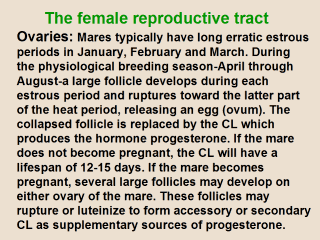| front |1 |2 |3 |4 |5 |6 |7 |8 |9 |10 |11 |12 |13 |14 |15 |16 |17 |18 |19 |20 |21 |22 |23 |24 |25 |26 |review |
 |
Oviducts:
The oviducts run from the ovaries to the uterus. The ovarian end of each
oviduct is fanned out and enlarged,called the fimbria. Fertilization occurs
in the upper 1/3 of the oviduct. Within the oviduct are ciliated cells which
help propel the egg towards the uterus. Uterus: The uterus contains a body and 2 horns. See illustration. The horns connect the uterus to the fallopian tubes and are about 26 cm long. The body is connected to each horn at roughly 90 degrees and about 20 cm long. The lining of the uterus is generally light pink in color and is made of longitudinal folds. The lining is termed the endometrium. Cervix: It is a muscular structure about 10 cm long. The cervix separates the uterus and the vagina. During pregnancy the cervix of the mare becomes quite firm and hard, and the external opening becomes sealed. Vagina: The vagina extends from the cervix to the vulva and is about 18 cm. The hymen is usually not present. Vulva: The vulva is the terminal part of the reproductive tract. It is about 10 cm long. The external orifice is a vertical slit about 17 cm long with the clitoris at the bottom. |